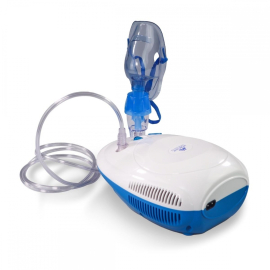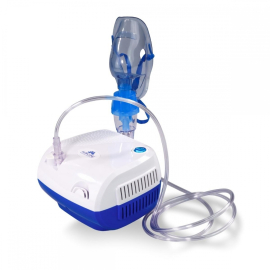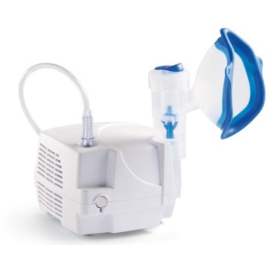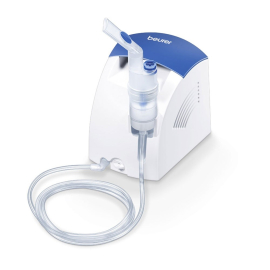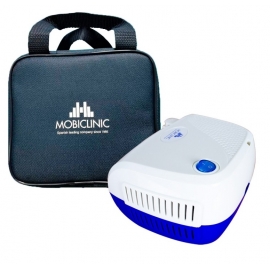
Νεφελοποιητής
It is a medical device designed to administer inhaled medication, suitable for the treatment of respiratory diseases.
What is a nebuliser?
It transforms a liquid medicine into small breathable particles or aerosol so that it can be inhaled by the person using it through a mask or mouthpiece. It is convenient and easy to administer as it is deliv...
- Σε απόθεμα Λάβετε το σε Πέμπτη51,00 €
- Σε απόθεμα Λάβετε το σε Πέμπτη46,95 €
- Σε απόθεμα Λάβετε το σε Πέμπτη83,00 €
- Σε απόθεμα Λάβετε το σε Πέμπτη98,45 €
It is a medical device designed to administer inhaled medication, suitable for the treatment of respiratory diseases.
What is a nebuliser?
It transforms a liquid medicine into small breathable particles or aerosol so that it can be inhaled by the person using it through a mask or mouthpiece. It is convenient and easy to administer as it is delivered directly to the user.
In this way, it is possible to administer a medicine in a comfortable and easy way and have it reach the respiratory tract directly, causing fewer side effects than by other means.
Benefits of the portable nebuliser
Benefits of the portable nebuliser
The medication nebuliser allows the drug to be deposited directly into the affected areas of the respiratory tract, making it more effective, faster and with fewer side effects.
It can be used with a wide variety of medications and combined in the same nebulisation. The dosage of the medication can also be regulated, adapting to the needs of the patient's treatment.
It improves the quality of life of those who need it, since the treatment can be carried out comfortably at home.
Types of nebulisers
They are differentiated according to the type of compressor they use to convert liquid medication into an aerosol, with three main types of nebuliser: inhaler nebuliser
compressor nebulisers, ultrasonic nebulisers and mesh nebulisers.
Nebuliser with compressor
The Mist machine uses compressed air, generated by an electric or gas compressor, to create the aerosol. It is very efficient, being used to nebulise bronchodilators, anti-inflammatory drugs, antibiotics and also saline. It is louder than the others.
It is very noisy.
Ultrasonic nebuliser
An ultrasonic fogger uses very high frequency (ultrasonic) vibrations to convert liquid into aerosol. They are faster, less noisy and are usually portable electric foggers. In addition, they can nebulise large quantities of liquids.
However, they are less commonly used and are not recommended for administering medication, as the heat generated in the vibration can alter the medication. They are mainly used to hydrate the upper airway by nebulising hypertonic saline.
Mesh Sprayer
Uses a mesh that vibrates at a high frequency to convert the liquid into an aerosol. This system allows this type of nebuliser to be compact and silent.
This is the fastest and most effective model. It requires more frequent cleaning. It is battery operated, so it serves as a portable fogger.
They are suitable for nebulising bronchodilators, anti-inflammatory drugs, antibiotics and also hypertonic saline solution.
How to use the nebuliser correctly
Preparing the nebuliser
The most important thing in preparation is hygiene, to avoid contamination by bacteria, viruses or fungi that can reach the respiratory tract. The person using it should wash their hands thoroughly before preparing the nebulisation.
The nebuliser should be prepared shortly before starting treatment and care should be taken to fill the container with the exact dose of medication.
The nebuliser should be prepared shortly before starting treatment and care should be taken to fill the container with the exact dose of medication.
Nebulisation
Nebulization
At the time of nebulisation, it is recommended to be seated close to the nebuliser, in a comfortable, upright position. With nebulisations with a respirator, you should breathe through your mouth slowly and deeply, making
apneas
(holding the air in) for a few seconds.
For the medicine to be fully inhaled and for the nebulisation to be effective, the mask must fit properly on the face or seal the lips tightly to the mouthpiece.
The duration of the nebulisation depends on the device and the dose of medication. Typically 10 to 15 minutes is typical.
Once the nebulisation is over, the mouth should be rinsed out properly with mouthwash to remove any remaining medication, especially if it contains corticosteroids. And if a mask has been used, the face and nose should also be washed.
Cleaning the nebuliser
It is important to clean the equipment thoroughly after use. The cleaning of each nebuliser should be in accordance with the manufacturer's instructions.
